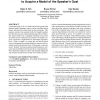Free Online Productivity Tools
i2Speak
i2Symbol
i2OCR
iTex2Img
iWeb2Print
iWeb2Shot
i2Type
iPdf2Split
iPdf2Merge
i2Bopomofo
i2Arabic
i2Style
i2Image
i2PDF
iLatex2Rtf
Sci2ools
KCAP
2005
ACM
2005
ACM
Matching utterances to rich knowledge structures to acquire a model of the speaker's goal
An ultimate goal of AI is to build end-to-end systems that interpret natural language, reason over the resulting logical forms, and perform actions based on that reasoning. This requires systems from separate fields be brought together, but often this exposes representational gaps between them. The logical forms from a language interpreter may mirror the surface forms of utterances too closely to be usable as-is, given a reasoner’s requirements for knowledge representations. What is needed is a system that can match logical forms to background knowledge flexibly to acquire a rich semantic model of the speaker’s goal. In this paper, we present such a “matcher” that uses semantic transformations to overcome structural differences between the two representations. We evaluate this matcher in a MUC-like template-filling task and compare its performance to that of two similar systems. Categories and Subject Descriptors I.2.4 [Artificial Intelligence]: Knowledge Representation Fo...
| Added | 26 Jun 2010 |
| Updated | 26 Jun 2010 |
| Type | Conference |
| Year | 2005 |
| Where | KCAP |
| Authors | Peter Z. Yeh, Bruce W. Porter, Ken Barker |
Comments (0)

